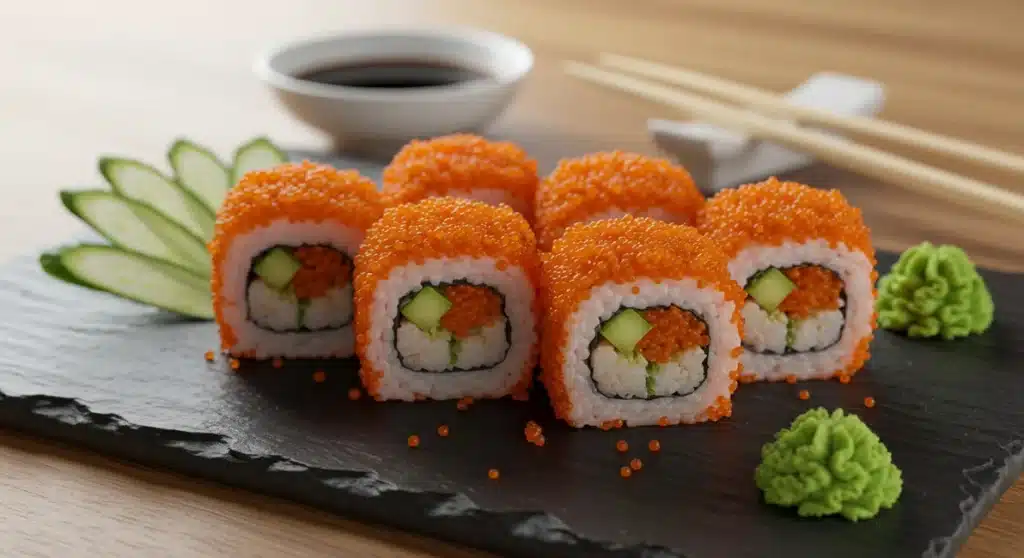Masago, also known as capelin roe, is a small, flavorful fish egg that has gained popularity in Japanese cuisine and beyond—especially as a sushi topping. Rich in nutrients and packed with umami flavor, this delicacy offers both culinary and health-related appeal. However, like all seafood products, it comes with pros and cons.
In this article, we explore everything you need to know about this roe, including its nutritional profile, benefits, potential downsides, and how to add it to your diet in a safe and delicious way.
What is Masago?
To begin with, the term refers to the eggs (roe) of the capelin fish, a small forage fish belonging to the smelt family. Capelin is found in the cold waters of the North Atlantic, Arctic, and North Pacific oceans.
In particular, this fish roe is commonly used in Japanese cuisine, particularly in sushi dishes such as California rolls and as a topping for nigiri or sashimi. It is often dyed bright orange for aesthetic appeal and to distinguish it from other types of roe.
How It Is Harvested
When it comes to harvesting, capelin females are harvested just before spawning when their eggs are most viable. These eggs are then separated, washed, and often mixed with salt, sugar, and flavor enhancers like soy sauce or wasabi.
Masago vs. Tobiko vs. Ikura
Many people confuse this roe with other types of fish eggs. Here’s how it differs:
| Type | Source | Size | Color | Flavor |
|---|---|---|---|---|
| Masago | Capelin | Small (0.5–1 mm) | Pale yellow to dyed orange | Mild and slightly salty |
| Tobiko | Flying fish | Medium (0.5–0.8 mm) | Bright orange | Crunchy, smoky |
| Ikura | Salmon | Large (5–6 mm) | Bright red/orange | Rich, buttery |
As a result, capelin roe is smaller and less crunchy than tobiko and significantly cheaper, making it a more economical option in many restaurants.
Nutrition Facts
Overall, this ingredient is low in calories but high in important nutrients, especially proteins and omega-3 fatty acids.
Nutritional Profile (per 1 oz / 28 grams)
- Calories: 40–50
- Protein: 6–7 grams
- Fat: 2–3 grams
- Carbohydrates: < 1 gram
- Omega-3 Fatty Acids: ~300 mg
- Vitamin B12: 100% DV
- Selenium: 56% DV
- Magnesium: 10–15% DV
- Iron: 10–15% DV
Moreover, it is also a source of other nutrients like zinc, phosphorus, and vitamin D.
✅ Tip: This roe is high in sodium due to processing—watch your intake if you’re on a low-salt diet.
Health Benefits
Thanks to its impressive nutrient content, this ingredient offers several health benefits.
Rich in Omega-3 Fatty Acids
Notably, this roe is a natural source of EPA and DHA, the two most crucial omega-3 fatty acids for brain, heart, and joint health. Omega-3s may help:
- Reduce inflammation
- Lower blood pressure
- Improve cognitive function
- Protect against heart disease
High-Quality Protein Source
Furthermore, it contains complete protein, meaning it provides all nine essential amino acids. This makes it a great choice for muscle repair and energy.
Excellent Source of Vitamin B12
Just one serving provides your daily requirement of vitamin B12, essential for nerve function and red blood cell formation.
Contains Antioxidants
In addition, capelin roe is rich in selenium and vitamin E, both powerful antioxidants that protect cells from damage.
Potential Risks and Side Effects
Although it is nutrient-dense, this seafood product may not be ideal for everyone.
High in Sodium
For instance, processed versions are often heavily salted, with up to 240 mg of sodium per tablespoon. Excessive sodium can lead to:
- High blood pressure
- Kidney strain
- Fluid retention
Allergen Risk
People with fish, shellfish, or egg allergies should avoid this roe. Also, cross-contamination is possible during sushi preparation.
Contains Additives
It’s worth noting that commercially available versions often include:
- Artificial colors
- Preservatives
- Flavor enhancers like monosodium glutamate (MSG)
Therefore, always read ingredient labels if you’re buying packaged products.
Environmental Sustainability
Moreover, overfishing of capelin can threaten marine ecosystems. Opt for roe from sustainable fisheries or look for certifications like MSC (Marine Stewardship Council).
How to Eat It
When it comes to versatility, this ingredient can be enjoyed in many different ways.
Common Ways to Use It
- Sushi Rolls: Topped or mixed inside (e.g., California rolls)
- Rice Bowls: Adds a salty pop to poke or chirashi bowls
- Appetizers: Flavored mayo dip or sushi tacos
- Garnish: Sprinkle over deviled eggs, seaweed salad, or ramen
Recipe Idea: Flavored Mayo
Ingredients:
- 1/2 cup mayonnaise
- 2 tbsp capelin roe
- 1 tsp lemon juice
- Optional: wasabi or sriracha for spice
Instructions:
Simply mix all ingredients in a bowl and refrigerate. Use as a sushi dip, sandwich spread, or seafood topping.
Storage Tips
To keep your roe fresh and safe, proper storage is essential:
- Refrigerated: Lasts up to 4–5 days once opened
- Frozen: Can be kept for up to 6 months
- Tip: Always thaw in the refrigerator, not at room temperature
Make sure to use clean utensils to avoid bacterial contamination.
Who Should Avoid It?
You should avoid or limit this food if you:
- Have hypertension or need a low-sodium diet
- Are pregnant, unless you’re sure it’s pasteurized
- Have seafood allergies
- Prefer to avoid artificial additives or dyes
To be safe, always consult a healthcare provider before adding new seafood to your diet—especially during pregnancy or when managing chronic conditions.
Where to Buy It
If you’re looking to purchase capelin roe, you can find it at:
- Japanese or Asian grocery stores
- Sushi-grade seafood markets
- Online retailers like Amazon or specialty seafood sites
🛒 Pro Tip: Choose frozen, vacuum-sealed packages for the best shelf life and freshness.
FAQs
Q1. Is this masago roe raw or cooked?
It is typically raw, although it is often cured with salt. When used in sushi, it is not cooked unless specified.
Q2. Is it safe to eat during pregnancy?
Pregnant individuals should avoid raw versions unless it’s confirmed pasteurized, due to the risk of listeria and mercury exposure.
Q3. Can vegetarians eat masago?
No, this product is not vegetarian as it comes from fish. However, some plant-based “roe” alternatives exist using seaweed-based ingredients.
Q4. What does it taste like?
Flavor-wise, this roe has a mild, salty, slightly sweet flavor with a soft, sandy texture that adds crunch to dishes.
Q5. Is it high in mercury?
Since it comes from small fish (capelin), it typically contains lower mercury levels than larger fish like tuna or swordfish.
Conclusion: Should You Include It in Your Diet?
In conclusion, this ingredient is a tasty, nutrient-rich seafood product that adds a unique flavor and texture to many dishes. It’s high in protein, omega-3s, and vitamin B12, making it a smart choice for those looking to boost their nutrient intake.







